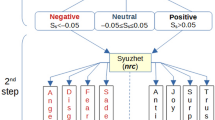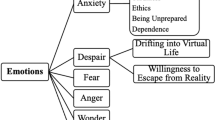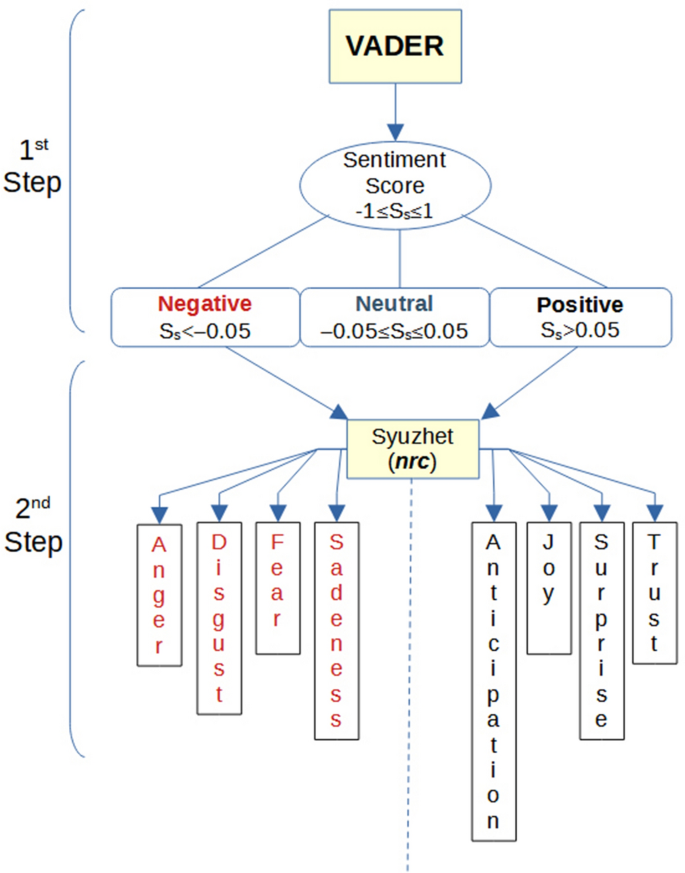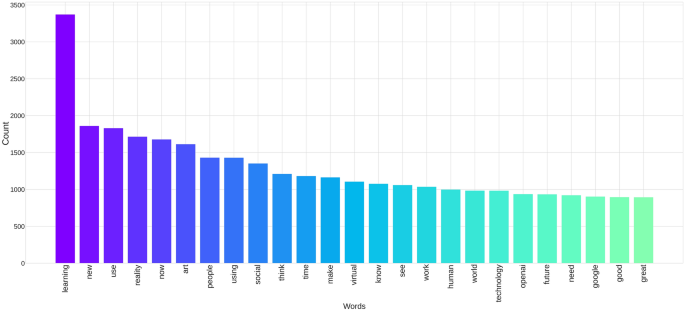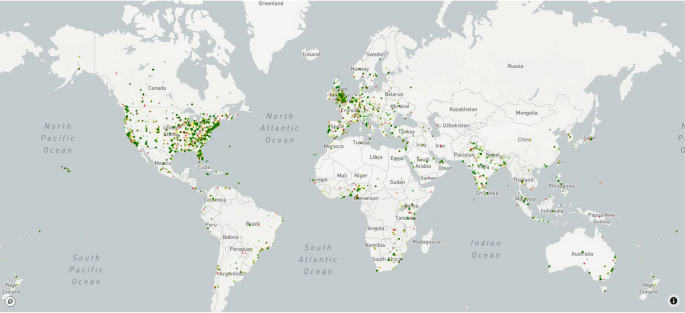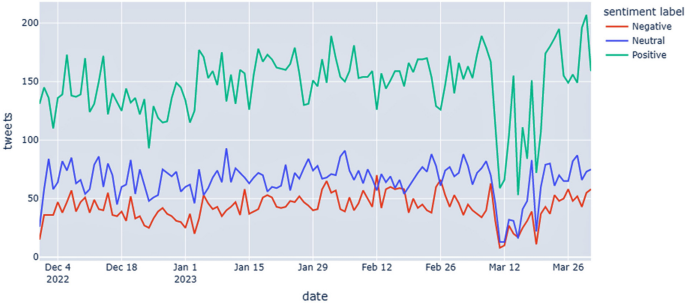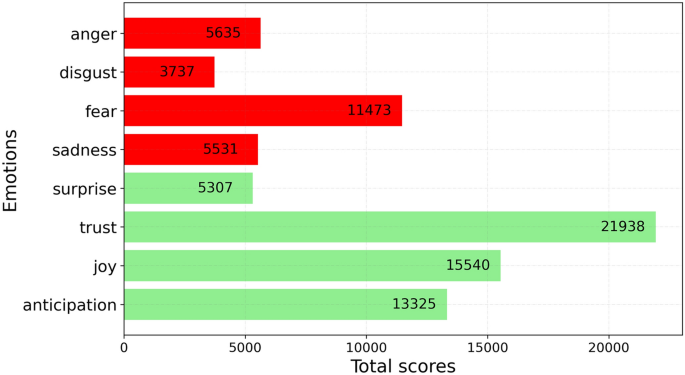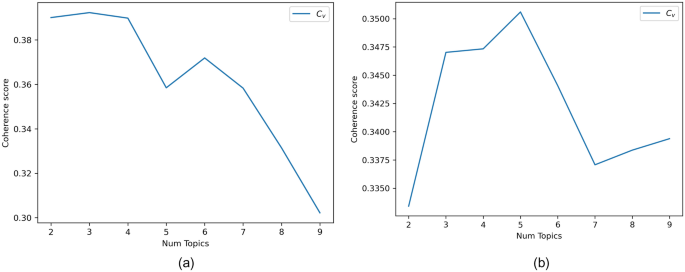Abstract
Today, teaching and learning paths increasingly intersect with technologies powered by emerging artificial intelligence (AI).This work analyses public opinions and sentiments about AI applications that affect e-learning, such as ChatGPT, virtual and augmented reality, microlearning, mobile learning, adaptive learning, and gamification. The way people perceive technologies fuelled by artificial intelligence can be tracked in real time in microblog messages promptly shared by Twitter users, who currently constitute a large and ever-increasing number of individuals. The observation period was from November 30, 2022, the date on which ChatGPT was launched, to March 31, 2023. A two-step sentiment analysis was performed on the collected English-language tweets to determine the overall sentiments and emotions. A latent Dirichlet allocation model was built to identify commonly discussed topics in tweets. The results show that the majority of opinions are positive. Among the eight emotions of the Syuzhet package, ‘trust’ and ‘joy’ are the most common positive emotions observed in the tweets, while ‘fear’ is the most common negative emotion. Among the most discussed topics with a negative outlook, two particular aspects of fear are identified: an ‘apocalyptic-fear’ that artificial intelligence could lead the end of humankind, and a fear for the ‘future of artistic and intellectual jobs’ as AI could not only destroy human art and creativity but also make the individual contributions of students and researchers not assessable. On the other hand, among the topics with a positive outlook, trust and hope in AI tools for improving efficiency in jobs and the educational world are identified. Overall, the results suggest that AI will play a significant role in the future of the world and education, but it is important to consider the potential ethical and social implications of this technology. By leveraging the positive aspects of AI while addressing these concerns, the education system can unlock the full potential of this emerging technology and provide a better learning experience for students.
Similar content being viewed by others
Introduction
AI-powered e-learning technologies
Current technology continues to advance, continuously transforming the way we live and the way we learn. Over the past few years, e-learning has become increasingly popular, as more people turn to online platforms for education and training. The COVID-19 pandemic has further accelerated this trend, as traditional classroom-based learning has become difficult, if not impossible, in many parts of the world.
Some of the key trends that we are also likely to see in the future of e-learning are as follows:
-
Adaptive learning. This method uses AI technology to personalize the learning experience for each student. This method adjusts the presentation of educational material according to an individual learner’s needs, preferences, and progress. By analysing students’ performance, it is possible to track their progress, and identify areas where they need more support or challenge.1,2,3
-
Immersive learning. This refers to an educational approach that involves deeply engaging learners in a simulated or interactive environment. It seeks to create a sense of immersion, in which individuals feel fully involved in the learning process through various sensory experiences. The primary goal is to enhance the understanding, retention, and application of knowledge or skills. The key components of immersive learning include virtual and augmented reality (VR/AR). These technologies are becoming increasingly advanced and accessible, and we are likely to see more e-learning platforms using these technologies.4,5 For example, a medical student could use VR to practice surgical techniques in a simulated operating room,6 or an engineering student could use AR to visualize complex machinery and processes.7
-
Microlearning. This refers to short, bite-sized learning modules that are designed to be completed in a few minutes or less. These modules are ideal for learners who have limited time or attention spans, and they can be easily accessed on mobile devices. In the future, we are likely to see more e-learning platforms using microlearning to deliver targeted, on-demand learning experiences.8,9
-
Gamification. This refers to the use of game-like elements, such as badges, points, and leaderboards, to increase engagement and motivation among learners. Through the addition of game-like features to e-learning courses, learners can be incentivized to complete assignments and reach learning goals; thus, the learning experience becomes more engaging and enjoyable.10,11,12
-
Mobile learning. With the widespread use of smartphones and tablets, e-learning is becoming more mobile-friendly, allowing learners to access course materials and complete assignments on the go. This makes learning more convenient and accessible, as learners can fit their learning into their busy schedules and on-the-go lifestyles.13,14
-
Social learning. Social media and collaborative tools can enable learners to connect and learn from each other in online communities.15 Learners can share their experiences, ask questions, and receive feedback from their peers, creating a sense of community and collaboration that can enhance the learning experience.16
-
Generative AI. This refers to a subset of artificial intelligence focused on creating new content or information. It involves algorithms and models that are capable of generating novel content that can resemble human-generaed data. In February, 2022, an AI generative system named AlphaCode was launched. This system has been trained to ‘understand’ natural language, design algorithms to solve problems, and then implement them in code. At the end of November 2022, a new generative artificial intelligence chatbot that was developed by OpenAI and named ChatGPT was launched. ChatGPT has a wide range of potential applications due to its ability to generate human-like responses to natural language input. Some of its potentialities include text generation, summarization of long texts into shorter summaries, language translation, question answering, text completion, text correction, programming code generation, equation solutions and so on. ChatGPT evolved into OpenAI’s most widely used product to date, leading to the launch of ChatGPT Plus, a pilot paid subscription, in March 2023. Overall, the potential of AlphaCode and ChatGPT are vast, and these tools are likely to be used in many applications in the future of e-learning, as their capabilities will continue to improve through further research and development. ChatGPT can be integrated as a conversational AI within e-learning platforms. It can provide real-time responses to queries, clarify doubts, offer explanations, and guide learners through course materials. It is a promising tool for language lessons since it can translate text from one language to another.17 To assist students and improve their writing abilities, ChatGPT may check for grammatical and structural problems in their work and provide valuable comments.18 Students can explore many things with the help of ChatGPT, such as developing a computer program, writing an essay and solving a mathematical problem.19 AlphaCode can aid e-learning platforms focused on programming or coding courses. It can provide code suggestions, explanations, and debugging assistance, helping learners better understand coding concepts.20
How people perceive AI-based technologies: general and e-learning-focused literature overview
In the literature, people’s perceptions of technologies fuelled by artificial intelligence (AI) can vary depending on various factors such as their personal experiences and cultural backgrounds, and the way in which AI is portrayed in the media. The following are some common perceptions of AI technologies:
-
Fear of Job Loss. One of the most common fears associated with AI technologies is that they will take over jobs previously performed by humans. This fear is especially prominent in industries such as manufacturing, customer service, translation21,22,23 and teaching24.
-
Improved Efficiency. Many people view AI technologies as a way to improve efficiency and accuracy in various fields. For example, AI-powered tools can improve students’ performance,25 AI-powered software can help doctors diagnose diseases,26 and chatbots can help students27 and customer service representatives answer queries more quickly.28
-
Ethical Concerns. There are concerns about the ethical implications of AI, such as bias in decision-making,29 invasion of privacy,30 and the potential for the development of AI-powered weapons.31 For example, schools and institutions use AI-powered technologies to analyse student academic performance and collect a large amount of personal identity data; if these data are leaked or misused, this will seriously affect students’ personal privacy and security. In addition, students have difficulty controlling their own data and understanding how it is being used and shared, which may also lead to concerns and mistrust regarding personal privacy.32,33
-
Excitement for Innovation. Some people are excited about the potential of AI to bring about new and innovative solutions to long-standing problems. For example, AI is being used to develop autonomous vehicles, which could revolutionize transportation,34 and new methods for teaching and learning music.35
-
Lack of Trust. Many people are still sceptical about the reliability and safety of AI technologies, especially given recent high-profile incidents of AI systems making mistakes36 or being manipulated.37 The lack of trust in the current application of generative AI in education mainly involves two aspects: opacity and reliability. When AI gives a result, it is difficult to explain the decision-making process, which makes it difficult for students to understand why they obtain a particular answer and how to improve their mistakes (opacity). Moreover, generative AI needs to be trained on a large dataset to ensure its effectiveness and reliability. For example, to train an effective automatic grading model, a large dataset of student essays and high-quality labelled data, such as scores for grammar, spelling, and logic, is needed. Insufficient datasets or low-quality labelled data may cause an automatic grading model to make mistakes and miss important aspects and affect its accuracy and application effectiveness.38
Overall, people’s perceptions of AI technologies are complex and multifaceted, are influenced by a range of factors and are likely to continue evolving as AI becomes more integrated into our lives.
Purpose and outline of the paper
Considering what has been said thus far, it could be interesting to explore sentiments and major topics in the tweets about the new AI-based technologies.
Social media are indeed a major and rich data source for research in many domains due to their 4.8 billion active users39 across the globe. For instance, researchers analyse user comments extracted from social media platforms (such as Facebook,40 Twitter,40 and Instagram41) to uncover insights into social issues such as health, politics and business. Among these platforms, Twitter is one of the most immediate; tweets flow nonstop on the bulletin boards of users. Twitter allows users to express and spread opinions, thoughts and emotions as concisely and quickly as possible. Therefore, researchers have often preferred to analyse user comments on Twitter to immediately uncover insights into social issues during the COVID-19 pandemic (e.g., conspiracy theories,42 why people oppose wearing a mask,43 experiences in health care44 and vaccinations45) or distance learning.46,47,48
Furthermore, we chose Twitter for its ability to immediately capture and spread people’s opinions and emotions on any topic, as well as for its ability to provide plentiful data, even in a short amount of time. Moreover, the people who have more direct experience with e-learning and AI technologies are students, teachers and researchers, i.e., persons of school or working age; that is, people who, by age, make up approximately 83% of Twitter users.49
The text content of a tweet is a short microblog message containing at most 280 characters. This feature makes tweets particularly suitable for natural language processing (NLP) techniques, which are widely used to extract insights from unstructured texts and can then be used to explore sentiments and major topics of tweets. Unlike traditional methods, which use surveys and samples to evaluate these frameworks and are expensive and time-consuming, NLP techniques are economical and fast and provide immediate results.
In this paper, we aim to answer three main questions related to the first months following the launch of ChatGPT:
-
What has been the dominant sentiment towards AI-powered technologies? We responded through a sentiment analysis of related tweets. We used VADER as a sentiment analysis tool.50
-
Which emotions about AI-powered technologies are prevalent? In this regard, we explored the emotions to the tweets using the Syuzhet package.51
-
What are the most discussed topics among those who have positive feelings and those who have negative feelings? With respect to this problem, we used the latent Dirichlet allocation (LDA) model.52
The findings from this study could aid in reimagining education in the postpandemic era to exploit technology and emerging strategies as benefits for educational institutions rather than as preparation for a new possible increase in infections. To this end, we decided to use only the technologies listed in “AI-powered e-learning technologies” as keywords for extracting tweets.
Methodology
The data
Twitter was chosen as the data source. It is one of the world’s major social media platforms, with 237.8 million active users in July 2022,53 and it is also a common source of text for sentiment analyses.54,55,56
To collect AI-related tweets, we used ‘Academic Account for Twitter API V2’, which provides historical data and allows for the data to be filtered by language and geolocation.57
For our study, we chose geolocated English-tweets only, posted from November 30, 2022 - March 31, 2023, with one or more of the following keywords: ‘ChatGPT’, ‘AlphaCode’, ‘virtual reality’, ‘augmented reality’, ‘micro-learning’, ‘mobile learning’, ‘adaptive learning’, ‘social leaning’, ‘AI’, ‘AI learning’ and ‘gamification’. A total of 31,147 tweets were collected.
Data preprocessing
In order to prepare the data for sentiment analysis, we employed various preprocessing techniques using NLP tools in Python. The steps we followed are as follows:
-
(1)
Eliminated mentions, URLs, and hashtags from the text,
-
(2)
Substituted HTML characters with their respective Unicode equivalents (e.g., replacing ‘ &’ with ‘ &’),
-
(3)
Removed HTML tags such as<br>,<p>, and others,
-
(4)
Eliminated unnecessary line breaks,
-
(5)
Removed special characters and punctuation except for exclamation points (the exclamation point is the only punctuation marks to which the used VADER lexicon is sensitive),
-
(6)
Excluded words that consist of only numbers.
For the second part, a high-quality dataset was required for the topic model. To achieve this, we removed duplicate tweets. In addition to the general data cleaning methods, we employed tokenization and lemmatization techniques to enhance the model’s performance.
We used the Gensim library58 to tokenize the text, converting all the content to lowercase to ensure uniformity in word representation. Next, we pruned the vocabulary by removing stop words and terms unrelated to the topic. Additionally, we created a ‘bigrams' model to capture meaningful word combinations.
Finally, we employed the ‘spaCy' library from NLTK59 to carry out lemmatization, which helped simplify words to their base form.
Sentiment and emotions analysis
To conduct sentiment analysis, we utilized the Valence Aware Dictionary for Sentiment Reasoning (VADER) algorithm, developed by Hutto et al.50 VADER is a sentiment analysis tool that uses a sentiment lexicon, a dictionary specifically designed for sentiment analysis, to determine the emotion intensity of sentiment expressed in a text. The lexicon consists of words or phrases with their accompanying sentiment ratings. It allows for efficient sentiment analysis of social media content and exhibits remarkable accuracy comparable to that of humans.
Using VADER, we assigned sentiment scores to the preprocessed text data of each tweet. We followed the classification method recommended by the authors, categorizing the sentiment scores into three main categories: positive, negative, and neutral (see Fig. 1—1st Step).
VADER has demonstrated outstanding performance in analysing social media text. Comprehensive rules to consider various lexical features, including punctuation, capitalization, degree modifiers, the contrastive conjunction ’but’ and negation flipping trigrams.
Next, we employed the ‘nrc' algorithm, a component of the R library Syuzhet package,51 to explore the underlying emotions associated with the tweet categories. In the ‘nrc' algorithm, an emotion dictionary is utilized to evaluate each tweet based on two sentiments (positive or negative) and eight emotions (anger, fear, anticipation, trust, surprise, sadness, joy, and disgust). Its purpose is to recognize the emotions conveyed within a tweet.
Whenever a tweet is connected to a specific emotion or sentiment, it receives points indicating the degree of valence in relation to that category. For instance, if a tweet includes three words associated with the ‘fear’ emotion in the word list, the tweet will receive a score of 3 in the fear category. Conversely, if a tweet does not contain any words related to a particular emotion, it will not receive a score for that specific emotion category.
When employing the ‘nrc’ lexicon, each tweet is assigned a score for each emotion category instead of a single algebraic score based on positive and negative words. However, this algorithm has limitations in accounting for negators and relies on a bag-of-words approach, disregarding the influence of syntax and grammar. Consequently, the VADER and ‘nrc’ methods are not directly comparable in terms of tweet volume and polarity categories.
Therefore, we utilized VADER for sentiment analysis and subsequently employed the ‘nrc' algorithm specifically for identifying positive and negative emotions. The sentiment analysis process follows a two-step procedure, as illustrated in Fig. 1. While VADER’s neutral tweets play a valuable role in classification, they are not particularly informative for emotion analysis. Therefore we focused on tweets exhibiting positive and negative sentiments. This methodology was the original source of our previous paper.60
The topic model
The topic model is an unsupervised machine learning method; that is, it is a text mining procedure that can be used to identify the topics or themes of documents in a large document corpus.61 The latent Dirichlet allocation (LDA) model is one of the most popular topic modelling methods; it is a probabilistic model for expressing a corpus based on a three-level hierarchical Bayesian model. Latent Dirichlet allocation (LDA) is a generative probabilistic model of a corpus. The basic idea is that documents are represented as random mixtures over latent topics, where each topic is characterized by a distribution over words.62 Particularly in LDA models, the generation of documents within a corpus follows the following process:
-
(1)
A mixture of k topics, \(\theta\), is sampled from a Dirichlet prior, which is parameterized by \(\alpha\);
-
(2)
A topic \(z_n\) is sampled from the multinomial distribution, \(p(\theta \mid \alpha )\) that is the document topic distribution which models \(p(z_{n}=i\mid \theta )\) ;
-
(3)
Fixed the number of topics \(k=1...,K\), the distribution of words for k topics is denoted by \(\phi\) ,which is also a multinomial distribution whose hyper-parameter \(\beta\) follows the Dirichlet distribution;
-
(4)
Given the topic \(z_n\), a word, \(w_n\), is then sampled via the multinomial distribution \(p(w \mid z_{n};\beta )\).
Overall, the probability of a document (or tweet, in our case) “\(\textbf{w}\) ” containing words can be described as:
Finally, the probability of the corpus of M documents \(D=\{\textbf{ w}_{\textbf{1}},...,{\textbf{w}}_{\textbf{M}}\}\) can be expressed as the product of the marginal probabilities of each single document \(D_m\), as shown in (2).
An essential challenge in LDA is deterining an appropriate number of topics. Roder et al.63 proposed coherence scores to evaluate the quality of each topic model. In particular, topic coherence is the metric used to evaluate the coherence between topics inferred by a model. As coherence measures, we used \(C_v\) which is a measure based on a sliding window that uses normalized pointwise mutual information (NPMI) and cosine similarity.63 This value is used to emulate the relative score that a human is likely to assign to a topic and indicate how much the topic words ‘make sense’. This score is used to infer cohesiveness between ‘top’ words within a given topic. For topic visualization we used PyLDAvis, a web-based interactive visualization package that facilitates the display of the topics that were identified using the LDA approach.52 In this package, each topic is visualized as a circle in a two-dimensional plane determined by principal components between topics and used Multidimensional scaling is used to project all the interrelated topic distances to two dimensions.64 In the best hypothetic situation, the circles have similar dimensions and are well spaced from each other, covering the entire space made up of the 4 quadrants of the graph. An LDA model is evaluated the better the more the coherence is and the closer the pyLDAvis visualization is to the hypothetical situation.
Results
Exploring the tweets
The word frequency of the most frequent 25 words terms are counted and visualized in Fig. 2. The words are related to new AI tools and have positive attributes such as ‘good’ or ‘great’.
All the tweets extracted were geolocated, but the ‘user location’ was detected in only approximately 85% of the tweets, highlighting the number of tweets that came from different counties around the world. The countries with the highest number of tweets are the United States and Great Britain (Fig. 3) but this result should be read considering that we have extracted tweets in the English language; therefore, it is normal that in countries where English is spoken, the number of tweets is very high. Notably, India and Europe also have a many Twitter users. In the United States, most Twitter users are located near the East and West Coasts. This figure also shows the polarity of the tweets: the colours red, yellow and green indicate negative, neutral and positive tweets, respectively.
Sentiment analysis
The sentiment score of a sentence is calculated by summing up the lexicon rates of each VADER-dictionary-listed word in the sentence. After proper normalization is applied, VADER returns a ‘compound’ sentiment score (\(S_s\)) in the range of \(-1\) to 1, from the most negative to the most positive. Once the score \(S_s\) is known, threshold values can be used to categorize tweets as positive, negative, or neutral (see Fig. 1—1st Step). According to our analysis, the output of the VADER model shows a great predominance of positive public opinion (Table 1). As an example, three tweets with their own polarity are shown in Table 2. Table 3 shows the number of total tweets with the related percentages and the percentages of positive, negative and neutral tweets of the various AI applications examined.
Regarding the timeline, the results showed that the number of tweets slowly increased during the observation period (Fig. 4). Clearly, as shown in the chart, there was a single weekly decline in the third week of March, likely due to the St. Patrick’s Day holiday, which fell close to the weekend (March 17).
The graph in Fig. 5 includes only the tweets with positive sentiment towards the 11 AI-based tools (categories). It returns the z scores of the relative frequencies \(Fr_{i}\) of positive tweets of the i-tool (\(i=1,...,11\)), where the z score is computed as follows:
A z score describes the position of a score (in our case \(Fr_i\)) in terms of standard deviation units from the average. This score is grater then 0 if the relative frequency of \(Fr_i\) lies above the mean, while it is less than 0 if \(Fr_i\) lies below the mean.
We preferred z scores to relative frequencies because the different categories have different averages: the z scores highlight the position of each \(Fr_i\) with respect to the average of all the relative frequencies.
In Fig. 5, we can see that the new generative AI ‘AlphaCode’ and ‘ChatGPT’ have scores that are much lower than and far from the average of positive sentiments. This could be due to concerns about the possible errors of such AI-based tools. Instead, ‘adaptive learning’, ‘social learning’ and ‘gamification’ lie above the mean of positive sentiments. This clearly attests to the more positive sentiment towards these tools, in our opinion largely due to their immediate feedback and to their attitude towards keeping learners engaged and motivated.
The second step of the analysis focused on identifying emotions in non-neutral tweets (see Fig. 1—2nd Step). Among the eight basic emotions, ‘trust’ was the most common positive emotion observed in the tweets, followed by ‘joy’, while ‘fear’ was the most common negative emotion (Fig. 6). These results need to be interpreted in light of recent literature on the psychological dimensions of AI-based e-learning technologies (see section "How people perceive AI-based technologies: general and e-learning-focused literature overview"). In the literature, the dimension of fear includes the fear of job loss for teachers but also for the entire working world,21,22,23,65 as well as concerns about AI systems making mistakes36 or being manipulated.37 The ‘trust’ dimension could be interpreted as the expectation that such technologies can improve the performance of students and people in general,26 while ‘joy’ could be associated with enthusiasm for the potential of artificial intelligence in creating new and innovative solutions.34
The topic model
To explore what concerns about AI-based tools Twitter users have, we applied the LDA model to our clean corpus of 28,259 words, which included only the following tagger components: nouns, adjectives, verbs and adverbs. Our goal was not to discover the topics discussed in the whole set of tweets but to detect the topics discussed in the positive sentiment tweets and the topics discussed in the negative sentiment tweets. Due to the large difference between the number of tweets with positive and negative sentiment polarity (57.58% vs. 16.65%), the application of the LDA model to the whole dataset would lead to not seeing the topics discussed in tweets with negative sentiment. Therefore, we chose to create two LDA models: one for tweets with positive polarity and one for those with negative polarity. For a better representation of the entire content, in each model, it is necessary to find an appropriate number of topics. By using topic numbers k ranging from 2 to 10, we initialized the LDA models and calculated the model coherence.
We used \(C_v\) coherence for both models as a first reference. This value indicates the degree of ‘sense’ and ‘cohesiveness’ of the main words within a topic.63
According to Fig. 7a, the coherence score peaked at 3 for the negative tweet model. In contrast, in the positive tweet model, the coherence score (Fig.7b) peaked at 3 and 5 topics. The choice of 5 topic numbers would lead to a nonuniform distribution on Principal Component (PC) axes displayed by pyLDAvis, which means that there is not a high degree of independence for each topic (see the LDAvis map in Supplementary Information ‘S2’ and ‘S3’). A good model is judeged by a higher coherence and an average distribution on the principal component analysis displayed by pyLDAvis.52 Therefore, we chose 3 as the topic number: the model has no intersections among topics, summarizes the whole word space well, and retains relatively independent topics.
The LDA analysis for negative and positive polarity tweets is shown in Table 4.
In the negative tweets, the first theme accounts for 37.5% of the total tokens and includes tokens such as ‘chatgpt’, ‘write’,‘art’, ‘need’, ‘thing’, ‘stop’ and ‘generate’. It is rather immediate to think that this negative opinion refers to tools such as ChatGPT and expresses concerns about its use in art and writing. People think that human creativity can generate art and literature rather than generative AI; for this reason, the use of generative tools in these contexts should be stopped. The second theme accounts for 33.3% of the total tokens and includes the words ‘bad’, ‘job’, ‘technology’, ‘scary’, ‘change’ and ‘learn’. We infer people’s fear of the changes that technology will bring in the world of job and learning. Several words, such as ‘kill’, ‘war’, ‘worry’ ,‘fear’, ‘fight’, ‘robot’ and ‘dangerous’, are mentioned in the third topic. This may indicate a sort of ‘apocalyptic fear’ that artificial intelligence could lead us to a new war and the end of humankind. For a map representation of the three topics, see the Supplementary Information ‘S1’.
In the positive tweets, the first theme accounts for 36.3% of the total tokens and includes tokens such as ‘learn’, ‘help’, ‘technology’, ‘student’ and ‘job’. Based on this, we inferred that people think that AI technologies have the potential to improve the job world and educational system. The second theme accounts for 34.7% of the total tokens, including the words ‘chatgpt’, ‘well’, ‘write’, ‘create’ and ‘ask’, showing people’s positive perception of AIs such as ChatGPT writing, asking questions and creating new solutions. After all, several words, such as ‘love’, ‘chatgpt’, ‘good’ ,‘answer’ and ‘believe’, are mentioned in the third topic. This indicates that people ‘believe in AI’ and trust tha AI, particularly ChatGPT provides good answers and solutions. For a map representation of the three topics, see the Supplementary Information ‘S2’.
Based on the LDA outputs, the following six topics were identified:
-
For ‘negative polarity’ tweets:
-
Topic 1: Concerns about ChatGPT use in art and writing
-
Topic 2: Fear of changes in the world of job and learning
-
Topic 3: Apocalyptic-fear.
-
-
For ‘positive polarity’ tweets:
-
Topic 1: AI technologies can improve job and learning
-
Topic 2: Useful ChatGPT features
-
Topic 3: Belief in the ability of ChatGPT.
-
Limitations
This study has several limitations, which can be summarized as follows.
-
(1)
Limitations related to the use of keywords to extract tweets. Sometimes, keywords can be ambiguous, leading to noise-affected results. Due to the dynamic nature of social media, trends and topics change rapidly. Keywords might quickly lose relevance as new terms emerge.
-
(2)
Limitations related to emotion analysis. A first limitation is that the number of emotion categories was limited to 8;51,66 however, emotion is a broad concept and, according to Cowen and Keltner67, may involve up to 27 categories. A second limitation is that misspelled words could not be identified or analysed in the algorithm. Further limitations involve the dictionary of sentiments (“lexicon”) developed by Mohammad and Turney for emotion analysis.51 This dictionary maps a list of language features to emotion intensities, where:
-
Only 5 individuals were recruited to annotate a term against each of the 8 primary emotions.
-
The emotions associated with a term were annotated without considering the possible term context.
-
Although the percentages of agreement were apparently high, interrater reliability statistics were not reported.
-
-
(3)
Limitations of topic analysis. Considering that LDA is an unsupervised learning technique, the main limitation is the degree of subjectivity in defining the topic created.45
-
(4)
Limitations of Twitter-based studies. Twitter data generally underestimate the opinions of people aged 50 and over, because approximately 83% of Twitter users worldwide are indeed under age 50.49 However, in the present study bias has an almost negligible impact: the future of AI-powered e-learning technologies indeed has a greater impact on younger people than on older people.
Conclusions and future perspectives
With the aim of studying the opinions and emotions related to AI-powered e-learning technologies, we collected tweets on this issue and carried out a sentiment analysis using the VADER and Syuzhet packages in combination with a topic analysis.
There is no doubt that artificial intelligence has the potential to transform the whole education system. The results showed a predominance of positive attitudes: topics with a positive outlook indicate trust and hope in AI tools that can improve efficiency in jobs and the educational world. Indeed, among the eight emotions of the Syuzhet package, ‘trust’ and ’joy’ were the most positive emotions observed in the tweets, while ‘fear’ was the most common negative emotion. Based on the analysis, two particular aspects of fear were identified: an ‘apocalyptic fear’ that artificial intelligence could lead to the end of humankind and a fear of the ‘future of artistic and intellectual jobs’, as AI could not only destroy human art and creativity but also make individual contributions of students and researchers not assessable.
In our analysis, people with positive sentiments were directed towards ‘adaptive learning’, ‘social learning’ and ‘gamification’. Therefore, from a future perspective, we can expect an ever-increasing implementation of these aspects in e-learning. AI could help educators ‘adapt learning’ techniques to tailor them to the individual student, with his or her own interests, strengths and preferences.
By analysing data about interactions between students, AI can identify opportunities for collaboration between students and thus transform ‘social learning’ into ‘collaborative learning’. AI could help educators create more effective group work assignments, provide targeted support to struggling students, and promote positive social interactions among them.
In class, instead of administering boring tests, AI-powered ‘games and simulations’ could increasingly provide engaging and interactive learning experiences to help students develop skills and knowledge in a fun and engaging way. Moreover, gamification could be increasingly useful for providing immediate feedback and monitoring student progress over time.
Despite our analysis highlighting the great potential of and people’s expectations for AI-based technologies, there is an aspect that cannot be elucidated by examining tweets.
Algorithms such as ChatGPT disrupt traditional text-based assessments, as students can query the program to research a topic that results in documents authored by an algorithm and ready to submit as a graded assignment. Therefore, we need to reimagine student assessment in new ways. The current debate is whether educators should ban artificial intelligence platforms through school internet filters38 or embrace algorithms as teaching and research tools.68
In March, 2023, Italy was the first government to ban ChatGPT as a result of privacy concerns. The Italian data-protection authority said there were privacy concerns relating to the model and said it would investigate immediately. However, in late April, the ChatGPT chatbot was reactivated in Italy after its maker OpenAI addressed issues raised by Italy’s data protection authority.
Regardless of privacy concerns, possible data manipulations or the right answers to AI-based tools, we believe that the future cannot be stopped.
Data availability
All data generated or analyzed during this study are included in the Supplementary Information Files of this published article.
References
Zahabi, M. & Abdul Razak, A. M. Adaptive virtual reality-based training: A systematic literature review and framework. Virtual Real. 24, 725–752. https://doi.org/10.1007/s10055-020-00434-w (2020).
Raj, N. S. & Renumol, V. G. A systematic literature review on adaptive content recommenders in personalized learning environments from 2015 to 2020. J. Comput. Educ. 9, 113–148. https://doi.org/10.1007/s40692-021-00199-4 (2022).
Al-Badi, A., Khan, A. & Eid-Alotaibi,. Perceptions of learners and instructors towards artificial intelligence in personalized learning. Proced. Comput. Sci. 201, 445–451. https://doi.org/10.1016/j.procs.2022.03.058 (2022).
Bizami, N. A., Tasir, Z. & Kew, S. N. Innovative pedagogical principles and technological tools capabilities for immersive blended learning: A systematic literature review. Educ. Inf. Technol. 28, 1373–1425. https://doi.org/10.1007/s10639-022-11243-w (2023).
Won, M. et al. Diverse approaches to learning with immersive virtual reality identified from a systematic review. Comput. Educ. 195, 104701. https://doi.org/10.1016/j.compedu.2022.104701 (2023).
Tang, Y. M., Chau, K. Y., Kwok, A. P. K., Zhu, T. & Ma, X. A systematic review of immersive technology applications for medical practice and education—trends, application areas, recipients, teaching contents, evaluation methods, and performance. Educ. Res. Rev. 35, 100429. https://doi.org/10.1016/j.edurev.2021.100429 (2022).
Wilkerson, M., Maldonado, V., Sivaraman, S., Rao, R. R. & Elsaadany, M. Incorporating immersive learning into biomedical engineering laboratories using virtual reality. J. Biol. Eng. 16, 20. https://doi.org/10.1186/s13036-022-00300-0 (2022).
Taylor, A.-D. & Hung, W. The effects of microlearning: A scoping review. Educ. Technol. Res. Dev. 70, 363–395. https://doi.org/10.1007/s11423-022-10084-1 (2022).
Wang, C., Bakhet, M., Roberts, D., Gnani, S. & El-Osta, A. The efficacy of microlearning in improving self-care capability: A systematic review of the literature. Public Health 186, 286–296. https://doi.org/10.1016/j.puhe.2020.07.007 (2020).
Oliveira, W. et al. Tailored gamification in education: A literature review and future agenda. Educ. Inf. Technol. 28, 373–406. https://doi.org/10.1007/s10639-022-11122-4 (2023).
Indriasari, T. D., Luxton-Reilly, A. & Denny, P. Gamification of student peer review in education: A systematic literature review. Educ. Inf. Technol. 25, 5205–5234. https://doi.org/10.1007/s10639-020-10228-x (2020).
Liu, T., Oubibi, M., Zhou, Y. & Fute, A. Research on online teachers’ training based on the gamification design: A survey analysis of primary and secondary school teachers. Heliyon 9, e15053. https://doi.org/10.1016/j.heliyon.2023.e15053 (2023).
Widiastuti, N. L. A systematic literature review of mobile learning applications in environmental education from 2011–2021. J. Educ. Technol. Inst. 1, 89–98 (2022).
Criollo-C, S., Guerrero-Arias, A., Jaramillo-Alcázar, A. & Luján-Mora, S. Mobile learning technologies for education: Benefits and pending issues. Appl. Sci.https://doi.org/10.3390/app11094111 (2021).
Chelarescu, P. Deception in social learning: a multi-agent reinforcement learning perspective. arxiv: 2106.05402 (2021)
Gweon, H. Inferential social learning: Cognitive foundations of human social learning and teaching. Trends Cogn. Sci. 25, 896–910. https://doi.org/10.1016/j.tics.2021.07.008 (2021).
Javaid, M., Haleem, A., Singh, R. P., Khan, S. & Khan, I. H. Unlocking the opportunities through chatgpt tool towards ameliorating the education system. BenchCouncil Trans. Benchmarks Stand. Eval. 3, 100115. https://doi.org/10.1016/j.tbench.2023.100115 (2023).
Sok, S. & Heng, K. ChatGPT for education and research: A review of benefits and risks. SSRN Electron. J.https://doi.org/10.2139/ssrn.4378735 (2023).
Yilmaz, R. & Karaoglan Yilmaz, F. G. Augmented intelligence in programming learning: Examining student views on the use of chatgpt for programming learning. Comput. Hum. Behav. Artif. Hum. 1, 100005. https://doi.org/10.1016/j.chbah.2023.100005 (2023).
Becker, B. A. et al. Programming is hard—or at least it used to be: Educational opportunities and challenges of AI code generation. In Proceedings of the 54th ACM Technical Symposium on Computer Science Education V. 1, SIGCSE 2023, 500–506, https://doi.org/10.1145/3545945.3569759 (Association for Computing Machinery, New York, 2023).
Ernst, E., Merola, R. & Samaan, D. Economics of artificial intelligence: Implications for the future of work. IZA J. Labor Policy 9, 55. https://doi.org/10.2478/izajolp-2019-0004 (2019).
Jaiswal, A., Arun, C. J. & Varma, A. Rebooting employees: Upskilling for artificial intelligence in multinational corporations. Int. J. Hum. Resour. Manag. 33, 1179–1208. https://doi.org/10.1080/09585192.2021.1891114 (2022).
Kirov, V. & Malamin, B. Are translators afraid of artificial intelligence?. Societieshttps://doi.org/10.3390/soc12020070 (2022).
Selwyn, N. Should Robots Replace Teachers?: AI and the Future of Education (John Wiley & Sons, 2019).
Baidoo-Anu, D. & Owusu Ansah, L. Education in the era of generative artificial intelligence (AI): Understanding the potential benefits of chatgpt in promoting teaching and learning. J. AI 7, 52–62. https://doi.org/10.61969/jai.1337500 (2023).
van Leeuwen, K. G., de Rooij, M., Schalekamp, S., van Ginneken, B. & Rutten, M. J. C. M. How does artificial intelligence in radiology improve efficiency and health outcomes?. Pediatr. Radiol. 52, 2087–2093. https://doi.org/10.1007/s00247-021-05114-8 (2022).
Shingte, K., Chaudhari, A., Patil, A., Chaudhari, A. & Desai, S. Chatbot development for educational institute. SSRN Electron. J.https://doi.org/10.2139/ssrn.3861241 (2021).
Wang, X., Lin, X. & Shao, B. How does artificial intelligence create business agility? Evidence from chatbots. Int. J. Inf. Manage. 66, 102535. https://doi.org/10.1016/j.ijinfomgt.2022.102535 (2022).
Parikh, R. B., Teeple, S. & Navathe, A. S. Addressing bias in artificial intelligence in health care. JAMA 322, 2377–2378. https://doi.org/10.1001/jama.2019.18058 (2019).
Mazurek, G. & Małagocka, K. Perception of privacy and data protection in the context of the development of artificial intelligence. J. Manag. Anal. 6, 344–364 (2019).
David, W. E. A. Ai-powered lethal autonomous weapon systems in defence transformation. Impact and challenges. In Modelling and Simulation for Autonomous Systems (eds Mazal, J. et al.) 337–350 (Springer International Publishing, 2020).
May, M. & George, S. Privacy concerns in e-learning: Is UsingTracking system a threat?. Int. J. Inf. Educ. Technol. 1, 1–8 (2011).
Ashman, H. et al. The ethical and social implications of personalization technologies for e-learning. Inf. Manag. 51, 819–832. https://doi.org/10.1016/j.im.2014.04.003 (2014).
Ma, Y., Wang, Z., Yang, H. & Yang, L. Artificial intelligence applications in the development of autonomous vehicles: A survey. IEEE/CAA J. Autom. Sin. 7, 315–329. https://doi.org/10.1109/JAS.2020.1003021 (2020).
Wei, J., Karuppiah, M. & Prathik, A. College music education and teaching based on AI techniques. Comput. Electr. Eng. 100, 107851. https://doi.org/10.1016/j.compeleceng.2022.107851 (2022).
Mahmood, A., Fung, J. W., Won, I. & Huang, C.-M. Owning mistakes sincerely: Strategies for mitigating AI errors. In Proceedings of the 2022 CHI Conference on Human Factors in Computing Systems, CHI ’22, https://doi.org/10.1145/3491102.3517565 (Association for Computing Machinery, New York, 2022).
Carroll, M., Chan, A., Ashton, H. & Krueger, D. Characterizing manipulation from AI systems. arxiv: 2303.09387 (2023).
Yu, H. & Guo, Y. Generative artificial intelligence empowers educational reform: Current status, issues, and prospects. Front. Educ.https://doi.org/10.3389/feduc.2023.1183162 (2023).
Kemp, S. Digital 2023: Global digital overview. (Accessed April 2023); Onlinehttps://datareportal.com/reports/digital-2023-april-global-statshot (2023).
Zhan, Y., Etter, J.-F., Leischow, S. & Zeng, D. Electronic cigarette usage patterns: A case study combining survey and social media data. J. Am. Med. Inform. Assoc. 26, 9–18. https://doi.org/10.1093/jamia/ocy140 (2019).
Hassanpour, S., Tomita, N., DeLise, T., Crosier, B. & Marsch, L. A. Identifying substance use risk based on deep neural networks and instagram social media data. Neuropsychopharmacology 44, 487–494. https://doi.org/10.1038/s41386-018-0247-x (2019).
Rains, S. A., Leroy, G., Warner, E. L. & Harber, P. Psycholinguistic markers of COVID-19 conspiracy tweets and predictors of tweet dissemination. Health Commun.https://doi.org/10.1080/10410236.2021.1929691 (2021).
He, L. et al. Why do people oppose mask wearing? a comprehensive analysis of U.S. tweets during the COVID-19 pandemic. J. Am. Med. Inform. Assoc. 28, 1564–1573. https://doi.org/10.1093/jamia/ocab047 (2021).
Ainley, E., Witwicki, C., Tallett, A. & Graham, C. Using twitter comments to understand people’s experiences of UK health care during the COVID-19 pandemic: Thematic and sentiment analysis. J. Med. Internet Res.https://doi.org/10.2196/31101 (2021).
Kwok, S. W. H., Vadde, S. K. & Wang, G. Tweet topics and sentiments relating to COVID-19 vaccination among Australian twitter users: Machine learning analysis. J. Med. Internet Res. 23, e26953. https://doi.org/10.2196/26953 (2021).
Aljabri, M. et al. Sentiment analysis of Arabic tweets regarding distance learning in Saudi Arabia during the COVID-19 pandemic. Sensors (Basel) 21, 5431. https://doi.org/10.3390/s21165431 (2021).
Mujahid, M. et al. Sentiment analysis and topic modeling on tweets about online education during COVID-19. Appl. Sci. (Basel) 11, 8438. https://doi.org/10.3390/app11188438 (2021).
Asare, A. O., Yap, R., Truong, N. & Sarpong, E. O. The pandemic semesters: Examining public opinion regarding online learning amidst COVID-19. J. Comput. Assist. Learn. 37, 1591–1605. https://doi.org/10.1111/jcal.12574 (2021).
Statista. Distribution of twitter users worldwide as of april 2021, by age group. Statista. https://www.statista.com/statistics/283119/age-distribution-of-global-twitter-users/ (2021).
Hutto, C. & Gilbert, E. Vader: A parsimonious rule-based model for sentiment analysis of social media text. In Proceedings of the 8th International Conference on Weblogs and Social Media, ICWSM 2014 (2015).
Mohammad, S. & Turney, P. Emotions evoked by common words and phrases: Using mechanical turk to create an emotion lexicon. In Proceedings of the NAACL HLT 2010 Workshop on Computational Approaches to Analysis and Generation of Emotion in Text (LA, California, 2010).
Sievert, C. & Shirley, K. LDAvis: A method for visualizing and interpreting topics. In Proceedings of the Workshop on Interactive Language Learning, Visualization, and Interfaces, 63–70, https://doi.org/10.3115/v1/W14-3110 (Association for Computational Linguistics, https://aclanthology.org/W14-3110, Baltimore, Maryland, 2014).
Kemp, S. Digital 2022: Twitter report (Accessed July 2022). Onlinehttps://datareportal.com/reports/digital-2023-deep-dive-the-state-of-twitter-in-april-2023 (2022).
Tumasjan, A., Sprenger, T., Sandner, P. & Welpe, I. Predicting elections with twitter: What 140 characters reveal about political sentiment. In Proc. Fourth Int. AAAI Conf. Weblogs Soc. Media Predict., vol. 10 (2010).
Oyebode, O., Orji, R. Social. & media and sentiment analysis: The Nigeria presidential election,. In 2019 IEEE 10th Annual Information Technology. Electronics and Mobile Communication Conference (IEMCON)2019, https://doi.org/10.1109/IEMCON.2019.8936139 (IEEE 2019).
Budiharto, W. & Meiliana, M. Prediction and analysis of Indonesia presidential election from twitter using sentiment analysis. J. Big Datahttps://doi.org/10.1186/s40537-018-0164-1 (2018).
Twitter APIV2. Academic Account for Twitter API V2. https://developer.twitter.com/en/products/twitter-api/academic-research (2022).
Řehuřek, R. & Sojka, P. Software framework for topic modelling with large corpora. In Proceedings of LREC 2010 workshop New Challenges for NLP Frameworks, 46–50 (Univerity of Malta, 2010).
Bird, S., Klein, E. & Loper, E. Natural Language Processing with Python (O’Reilly Media, 2009).
Stracqualursi, L. & Agati, P. Tweet topics and sentiments relating to distance learning among Italian twitter users. Sci. Rep. 12, 9163 (2022).
Blei, D. M., Ng, A. Y., Jordan, M. I. & Lafferty, J. Latent dirichlet allocation. J. Mach. Learn. Res. 3, 993–1022 (2003).
Lee, J. et al. Ensemble modeling for sustainable technology transfer. Sustainability 10, 22–78. https://doi.org/10.3390/su10072278 (2018).
Röder, M., Both, A. & Hinneburg, A. Exploring the space of topic coherence measures. In Proceedings of the Eighth ACM International Conference on Web Search and Data Mining - WSDM ’15 (ACM Press, 2015).
Sievert, C. & Shirley, K. Package ldavis (Online) https://cran.r-project.org/web/packages/LDAvis/LDAvis.pdf (2022).
Edwards, B. I. & Cheok, A. D. Why not robot teachers: Artificial intelligence for addressing teacher shortage. Appl. Artif. Intell. 32, 345–360. https://doi.org/10.1080/08839514.2018.1464286 (2018).
Plutchik, R. A general psychoevolutionary theory of emotion. In Theories of Emotion, 3–33, https://doi.org/10.1016/b978-0-12-558701-3.50007-7 (Elsevier, 1980).
Cowen, A. S. & Keltner, D. Self-report captures 27 distinct categories of emotion bridged by continuous gradients. Proc. Natl. Acad. Sci. U. S. A. 114, E7900–E7909. https://doi.org/10.1073/pnas.1702247114 (2017).
Reyna, J. The potential of artificial intelligence (AI) and chatgpt for teaching, learning and research. In EdMedia+ Innovate Learning, 1509–1519 (Association for the Advancement of Computing in Education (AACE), 2023).
Author information
Authors and Affiliations
Contributions
L.S. and P.A. contributed equally to this work. Particularly, L.S. wrote the main text of the manuscript, contributed to the formal analysis, conceptualization, investigation and creation of the software in Python. P.A. contributed to the formalization of the applied methodology, to the data management, to the preparation of the figures, to the supervision and to the revision and modification of the manuscript.
Corresponding author
Ethics declarations
Competing interests
The authors declare no competing interests.
Additional information
Publisher's note
Springer Nature remains neutral with regard to jurisdictional claims in published maps and institutional affiliations.
Supplementary Information
Rights and permissions
Open Access This article is licensed under a Creative Commons Attribution 4.0 International License, which permits use, sharing, adaptation, distribution and reproduction in any medium or format, as long as you give appropriate credit to the original author(s) and the source, provide a link to the Creative Commons licence, and indicate if changes were made. The images or other third party material in this article are included in the article’s Creative Commons licence, unless indicated otherwise in a credit line to the material. If material is not included in the article’s Creative Commons licence and your intended use is not permitted by statutory regulation or exceeds the permitted use, you will need to obtain permission directly from the copyright holder. To view a copy of this licence, visit http://creativecommons.org/licenses/by/4.0/.
About this article
Cite this article
Stracqualursi, L., Agati, P. Twitter users perceptions of AI-based e-learning technologies. Sci Rep 14, 5927 (2024). https://doi.org/10.1038/s41598-024-56284-y
Received:
Accepted:
Published:
DOI: https://doi.org/10.1038/s41598-024-56284-y
Comments
By submitting a comment you agree to abide by our Terms and Community Guidelines. If you find something abusive or that does not comply with our terms or guidelines please flag it as inappropriate.


